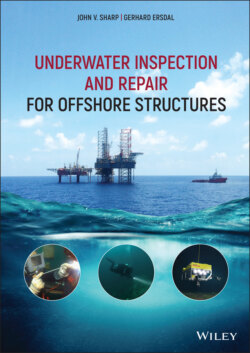Читать книгу Underwater Inspection and Repair for Offshore Structures - Gerhard Ersdal - Страница 24
2.1 Introduction
ОглавлениеA number of different regulatory regimes exist for offshore installations for different parts of the world. The regulatory regimes in USA, UK and Norway in many ways took the lead in the development of these, although well‐developed regulations can now be found in, for example Brazil, Canada and Australia. ln the North Sea, the major change has been the development of risk‐based regulations, initially in Norway and since the mid‐1990s in the UK. These regulations specify high‐level safety requirements (goals) to be achieved through the design, fabrication and operational stages. These regulations are further supported by recognised standards. Some regulatory regimes are more prescriptive with respect to the standards to be used.
Inspection and repair of offshore structures are often regulated as a part of the structural integrity management (SIM) requirements. The purpose of SIM is to identify all types of changes relevant to the safety of a structure in operation, to evaluate the impact of these changes and mitigate (e.g. repair) the impact of these if found necessary. Such changes include anomalies detected during inspections or condition monitoring, changes in loads and configuration and changes to requirements from improved standards. Mitigation will typically be various forms of repair, load reduction or operational restrictions.
A standard or recommended practice for integrity management should guide the responsible party to manage all aspects of safety and functionality for the structure. This will typically be achieved by a major hazard approach based on an established risk picture, describing what can go wrong and how one can protect the structure if such failures should occur. Hence, the structural integrity management should be based on an understanding of the possible hazards to the structure and marine systems (for floating structures) and the severity of the consequence of these types of damage. A standard should further include good methods for planning the necessary inspections and surveys to establish an understanding of any change or anomaly influencing the safety of the structure.
Ersdal, Sharp and Stacey (2019) stressed that changes to structures and marine systems may be physical, technological, knowledge based, related to safety requirements in regulations or standards and changes to information about the structure. Although all these changes can be important, physical changes will often dominate the SIM work. The detection of these physical changes results from rather costly offshore structural inspections, structural monitoring, weight monitoring and metocean observations. The other types of change should not be overlooked and these will often include document review, updated engineering methods and standards and maintaining a proper database containing all necessary information about the structure (see Section 6.1.5).
The general principles for the management of physical assets were introduced in PAS 55 (BSi 2008). Although this standard is not sufficiently detailed for structural integrity management, its principles include keeping the asset (in this context structure and marine system) unimpaired and in sound condition throughout the life cycle, whilst protecting health, safety and the environment. This type of integrity management approach has been incorporated in some of the latest structural integrity management standards and recommended practices such as API RP‐2FSIM (API 2019a), API RP2‐MIM (ISO 2019b), ISO 19901‐9 (ISO 2019a) and NORSOK N‐005 (Standard Norge 2017b), as discussed later in this chapter.
A major hazard approach is relevant to all types of structures, but for marine systems related to floating structures, many of these hazards and controls relate to factors such as ballast controls and weight distribution, which can change on a daily basis.
UK HSE commissioned Atkins to prepare a report providing an overview of the required structural integrity management for fixed offshore structures (HSE 2009). The aim of the programme was to develop a comprehensive framework, as illustrated in Figure 7, for the structural integrity management (SIM) of fixed jacket structures based on HSE’s technical policy in this area. The framework was seen as a mechanism for communicating good industry practice and hence to encourage continual improvement in performance. The inspection strategy and programme, information management, evaluation and sub‐sea intervention feature prominently.
Figure 7 Elements of Structural integrity management, based on HSE (2009).
Source: Based on HSE (2009), HSE RR684 ‐ Structural integrity management framework for fixed jacket structures, Health and Safety Executive (HSE), London, UK.
In addition, the report provided guidance on how to implement the framework. The document had been developed largely on the basis of existing standards and industry published documents including ISO 19902 (ISO 2007), API RP‐2SIM (API 2014b) and PAS 55‐1 (BSI 2008).
